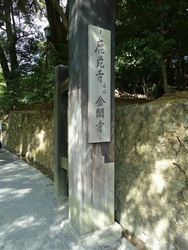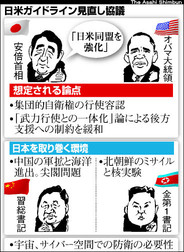 Source: jimmyblanca.blogspot.com
Source: jimmyblanca.blogspot.com Kyoto society during the medieval period periodically witnessed acts of violence committed by the members (or followers) of various temples and shrines. Some of the most pugilistic belonged to Rokuonji temple and Kitano Tenmangū (or Kitano-sha), and it was just such a clash between the followers of both institutions that brought Kitano-sha within a hair’s breadth of being attacked by a much larger group from Rokuonji. Fortunately for posterity (and those inside Kitano-sha at the time), Muromachi Shōgun Ashikaga Yoshinori received news of the impending attack and sent troops of his own to prevent it from happening thereby keeping any damage to a minimum. Strangely enough, it was the most innocuous of incidents that led in turn to the Shōgun having to call out the troops, and concerned a perceived insult against Rokuonji by two members of the Kitano-sha. (12)
The incident itself began when seven or eight priests belonging to Kitano-sha decided to pay a visit to Rokuonji in order to do a bit of sightseeing. The priests themselves had travelled from the provinces to the capital in order to participate in the ‘Kanjin Kusemai’ (勧進くせ舞, or a temporary ritual performed in order to raise funds for the construction of new temple buildings), and were making their way back home when they decided to call in to Rokuonji, which none of them had seen before. Two young servants that were accompanying the priests had already gotten drunk on alcohol before venturing to the gates outside Rokuonji, and were quite intoxicated. It was at precisely this time that a priest of Rokuonji, not exactly acting in keeping with his profession, was standing in front of the entrance gates to the temple complex relieving himself (aka, taking a quick leak). (12)
According to testimonies that were taken afterwards, one of the servants in the Kitano-sha priests’ retinue suddenly ‘laughed’ at the Rokuonji priest. In their deposition, Rokuonji claimed that the Kitano-sha priests and their servants had all said to the Rokuonji priest…’牛が罷り透る’ (hey, a cow is ‘passing by’). This, according to Rokuonji, was what sparked the incident. It may of course be possible that the Kitano-sha group slandered the Rokuonji priest by comparing him to a urinating cow, and while this wouldn’t really elicit a response today, it’s clear that as a result of some sort of provocation by the Kitano-sha group things soon got out of hand. (13)
If all that occurred was an exchange of drunken words then that would have preferable to what followed. However, given the times in which the incident occurred, there was no way that the Rokuonji priest could let the matter go. The priest then made a retort to the Kitano-sha group, of sufficient vitriol to cause the Kitano-sha group to become enraged. As the priest was outnumbered, he ran off with the Kitano-sha group in pursuit. Eventually the priest sought sanctuary within the grounds of Rokuonji temple, where despite their best efforts, the Kitano-sha group could not prise him out. Instead they then set about trying to break down the gates at the front of the temple in order to force their way in. (13)
Clearly this attempt to force their way into the temple was doomed to fail, however at that moment an old priest from Rokuonji made an appearance and attempted to placate the anger of the Kitano-sha group. Yet given the state of intoxication that the Kitano-sha group had fallen into, the priest’s words fell on deaf ears. Moreover, some of the group had already drawn their swords and attempted to cut the old priest down where he stood. In this period it was quite common for priests to carry weapons on their person. As such, every so often what began as a verbal argument could escalate into murder. (14)
Realising that he didn’t have a chance against the drunken priests from Kitano-sha, the old priest ran back into the Rokuonji temple grounds and began to ring the temple bell to alert the surrounding area to the emergency that was now unfolding. Realising that something was wrong, those townspeople and priests who lived in the area in front of the temple quickly rushed to the scene. It was at that moment that the front of Rokuonji temple was transformed into a bloodbath. The priests from Kitano-sha became enveloped in an exchange of blows with the townspeople and priests of Rokuonji. According to one record, two of the priests from Kitano-sha were cut down, while one of the Rokuonji supporters was killed. According to a separate account, one of the Kitano-sha group was killed, one was wounded but ran off, while a third was captured. No matter was the result was, the fact of the matter was that what had begun as a simple visit to Rokuonji had transformed into a dramatic battle to the death. (14)
However things did not end here. The followers of Rokuonji, enraged by the insults and outrageous behaviour of the priests from Kitano-sha, decided that they would take their revenge on Kitano-sha itself. It was just at the moment when the two sides were preparing to engage in all-out warfare that the situation changed dramatically. Having gotten word of the crisis, Ashikaga Yoshinori issued orders to his officials Inō Tametane and Matsuda Ushihide, telling them to clamp down on the Rokuonji followers. It was this intervention by the Shōgun that brought the matter to a close. (14)
Nowadays Rokuonji is a major tourist attraction, annually visited by around 5 million people. Yet there are probably none among the many visitors who realise that a fight to the death took place just outside the front gates of the temple complex. Yet the fact that such a vicious, and ultimately meaningless conflict could occur just outside the gates of Rokuonji, itself a symbol of the authority of the Muromachi Bakufu, is indicative of the age in which such events were common. It was all the more tragic given that the incident, in which people lost their lives and required the intervention of the Shōgun, came about as a result of the mere utterance of a childish insult or some such thing, the carelessness of a young servant, and a priest taking a quick leak. (15)
To modern eyes, this seems like such a petty, nonsensical act, yet to the people of the time it was deadly serious. Clearly the fact that the servants had ‘laughed’, and that the priest had been compared to a ‘cow’, carried with it some profound meaning. In that day and age, “laughing at others, and being laughed at” could, depending on the circumstances, lead to very serious problems indeed. (15)


 RSS Feed
RSS Feed